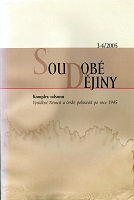"V zájmu ochrany hranic": Přesídlení obyvatel ze zakázaného a hraničního pásma (1951–1952)
"In the Interest of Protecting the Borders": Resettlement of the Inhabitants from the Border Zone and Forbidden Zone, 1951–52
Author(s): David KovaříkSubject(s): History
Published by: AV ČR - Akademie věd České republiky - Ústav pro soudobé dějiny
Summary/Abstract: The article aims to describe the forced resettlement of the inhabitants from the areas at the western frontier of Czechoslovakia in consequence of the aim of the State to increase the ‘security’ of these areas at the height of Stalinism and the Cold War. The border zone was set up in April 1950, and ran in a width of between two and six kilometres from the demarcation line. A year later a 'forbidden zone' was drawn over it, which ran a consistent two kilometres in width from the frontier and included 126 villages. Whereas people branded ‘politically unreliable’ (státně nespolehliví) were forced to move out of the border zone, while others were subject to various security measures, everyone was forced to move out of the forbidden zone. More than 5,000 people were affected by the operation, which took place from November 1951 to April 1952, overseen by the state security forces. The author notes that often neither the public nor even the local authorities were sufficiently informed; though rumours spread and people grumbled, few spoke out openly against it, and, from the point of view of the authorities, the operation took place largely without complications. On a smaller scale forced migration continued in consequence of the adjustments to the border zone and the forbidden zone. From 1952 to 1960 more than 100 villages were obliterated in the forbidden zone, and more than 45,000 buildings were demolished in the depopulated villages of the borderlands.
Journal: Soudobé Dějiny
- Issue Year: XII/2005
- Issue No: 03-04
- Page Range: 686-707
- Page Count: 22
- Language: Czech

